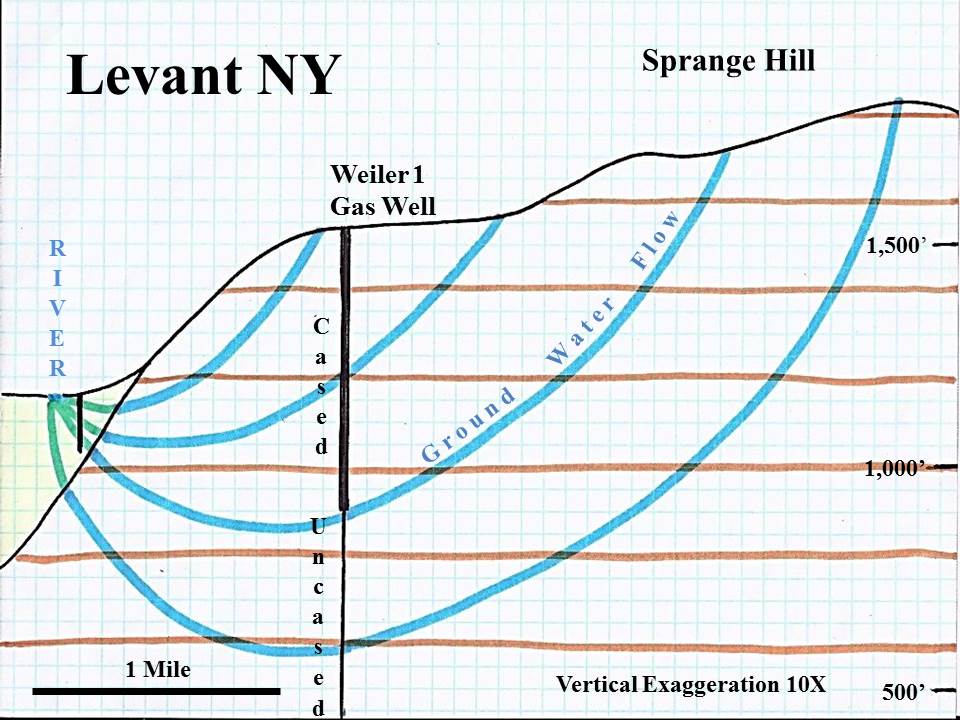Oil & Gas Pollution in New York State
Part II
The Short Reports:
In the last 30 years or so, there have been dozens of reports of oil, gas, or brine polluting the water and air in New York State. But the Division of Mineral Resources (DMN) has failed to find the oil and gas industry responsible for a single incident of subsurface pollution, except for one malfunction and one operator error, both during drilling. Can the exploration and production of petroleum in New York be that immaculate?
For virtually all of these reported incidents, the determinations by DMN are poorly documented, and therefore their work cannot be methodically reviewed. The exception is gas pollution of the Short family homestead, hamlet of Levant, Town of Poland, Chautauqua County. During the 1980s, investigations of this pollution produced several reports.
In the early fall of 1983, the Shorts noticed changes in their well water, such as “cloudiness, bubbling and high pressure.” On the morning of November 1st, the wood-plank cover of their underground well house blew apart. The responding fire department notified the county fire coordinator, who notified the DEC. Staff was on the scene by the afternoon of the 3rd.
Examination of the property found gas coming out of the cellar’s dirt floor and the lawn. Within two days, the local distributer of natural gas, National Fuel Gas, determined that this gas chemistry did not match theirs.
DMN began their investigation by reviewing the paperwork of several gas wells in the hills above. [See map below.] Finding it in order, they looked around the well heads. One small leak was found, which was venting into the air. This took a week.
View Levant, Town of Poland, Chautauqua County, NY in a larger map
In the map above, polluted water wells (pushpins) are clustered in the valley, whereas gas wells are distributed throughout the hills above. Click on link below map to see details of water and gas wells.
Having “exhausted its resources,” the DMN wrote to Mr. Short on November 23rd that “the natural gas being released from the ground is either a naturally occurring phenomenon (swamp gas due to surrounding swamps, or shallow gas – a naturally occurring natural gas formation in Chautauqua County) or a product of some other physical means outside the experience of this office.” (They meant “marsh,” not “swamp.”) DMN seems to be a division of few resources and little experience.
Like most DMN investigations, this one might have ended there except for exceptional coincidences. Mr. Short was wholly unsatisfied by their response and complained loud and long at many venues that winter. Eventually, it became clear that more than a dozen homes and businesses in Levant were also polluted. Levant is on the edge of Jamestown, and that city was concerned about pollution of their aquifers, one of which is in the Town of Poland. Chautauqua County had a long-running dispute with DMN over gas pollution. Mr. Short hired a hydrologist to investigate his pollution. And the NYS Attorney General became involved.
In the spring of 1984, DMN reopened their investigation. New work included sampling gas from Mr. Short’s property and nearby gas wells, a magnetic survey for buried abandoned wells, and listening at well heads for the sound of leaks.
In May, the DEC report confirmed the conclusion of their initial letter: “The ebullient gas is more marsh-like in chemical composition than production gas,” even though the gas contained minor amounts of ethane and propane, which are found in petroleum gas but not in marsh gas.
And that “other than minor casing head leaks at the surface, the well-bores have maintained their integrity.” Even though contact microphones might pick up leaks through the upper hundreds of feet of cased well-bore, but not leaks though the lower thousands of feet of uncased well-bore.
To explain the sudden appearance of gas at the Shorts’, DEC wrote: “Three weeks prior [to the explosion] … New York experienced the largest earthquake in 40 years…the earthquake may have opened fissures permitting the contained gas to escape.” Never mind that the epicenter of the Blue Mountain Lake earthquake was in the Adirondacks over 270 miles away.
In July, the Shorts’ consultant Dr. Harrison concluded that “the gas causing the problem in the Levant area could not be swamp gas,” and that “it is extremely unlikely that a recent earthquake caused a release of Devonian shale gas or Medina gas.” Instead the pollution was “caused by activities associated with gas well drilling and production,” specifically because these wells were not cased in cement for most of their length, so gas built up in the shaft and leaked into the bedrock.
With the gas wells in the hills above Levant, the downward flow of ground water could carry the gas from their uncased lengths to the sands and gravels beneath Levant, where it could then rise toward the surface [See cross section below].

Slice through the earth above the hamlet shows groundwater flowing from the recharge area on the hill to discharge area in the valley. This flow can carry shale gas from uncased gas wells 4,000’ deep to Short’s water well 120’ deep. While Weiler 1 is cased down to 652’, other gas wells in the area are cased down to only about 300’.
That August, DMN ordered the two operators, Bounty Oil & Gas and Union Drilling, to vent to the atmosphere the space between the pipe carrying the gas up from depths and the wall of the well-bore.
Dr. Harrison proposed to Assistant Attorney General Moore a joint investigation to resolve their disagreements. It began in February of 1985 with contributions from DMN staff, Peter Skinner of the Attorney General’s office, Henry Baily of the NYS Geological Survey, and Harrison himself.
Roger Waller from US Geological Survey proposed using carbon isotopic dating. Samples collected by Mr. Skinner were analyzed by Krueger Enterprise of Cambridge MA. Results showed that the gas was too old to date by this method – over 40,000 years old. Therefore, it could not be marsh gas.
Dr. Harrison built devices to measure the volume of gas vented from water wells and installed them in four homes. The volume of gas in the Shorts’ well decreased after the wells were vented, suggesting that one or more of those wells were the source of the gas.
Despite the accumulated evidence, in March 1986, DMN concluded that “Conflicting trends in a deficient collection of data have not produced conclusive evidence to pinpoint the source of the gas” and that “it may ultimately prove impossible to pinpoint the source of the gas.”
The DMN investigated for two more years, with further analyses of gas and water and measurements of the depths of gas-bearing layers (mud-logging) in a new gas well. With the release of the final report in May 1989, Director Sovas of the DMN said, “All the work we have done suggests that gas exists in the area, but I can’t say one thing is causing it or not.”
While DMN conceded that the polluting gas is petroleum, it did not confirm that gas came from any gas well, let alone identify a particular well. What is more, DMN continued to promote an Adirondack earthquake as the cause of the onset of pollution rather than the drilling of local gas wells.
The tenacity of Mr. Short, the scientist that he hired, and government officials at all levels pressured DMN into producing hundreds of pages of reports. Yet in over five years of investigations, DMN failed to identify the source of pollution.
Given the mountain of evidence concerning the shale gas pollution of the Levant aquifer, if not there, where and when will the DMN ever hold the oil and gas industry accountable?
NOTE: In May of 1984, Tim and Debbie Short along with their three sons moved out of their home and into a trailer in Ellery, 13 miles away. Their polluted house remained unsold for many years, gradually decaying. After spending several thousand dollars on a consultant and a lawyer, the Shorts filed a lawsuit in 1986, but ultimately did not take their suit to trial.
For full details of our request for more information, see Freedom of Information Law request – FOIL 11-1415.
